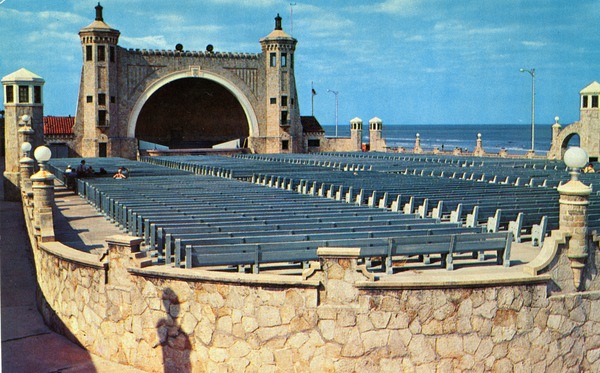









The City of Daytona Beach Oceanfront Bandshell and Oceanfront Park Complex is not just an incredible place to catch a concert, it also features about 3 acres of a long, narrow, grassy strip of park that stretches from the southern end of the Bandshell seating area south to Auditorium Boulevard! Located directly along the oceanfront, The Daytona Beach Oceanfront Bandshell and Park is known to be one of the premiere open-air entertainment venues in the southeastern United States, as well as one of the most important tourist attractions in the city. Known for its annual free summer concerts, The Bandshell has also hosted everyone from Blake Shelton to Buddy Guy to Huey Lewis & The News! The Oceanfront Bandshell remains an iconic landmark in Daytona Beach for artists to perform.
CONSTRUCTING THE BANDSHELL
Beginning in 1934, city officials, led by Mayor Edward H. Armstrong, began lobbying the federal government for money to construct a large outdoor amphitheater on Daytona Beach. Armstrong's vision for the complex was to make it the largest and most attractive open-air facility on the east coast. Finally, after nearly two years of negotiation and an offer to put up a significant amount of City funds, the project was approved in January 1936 and placed under the jurisdiction of the WPA, which sponsored hundreds of civic improvement projects throughout Florida during the Great Depression. This project cost the city $84,000 and the Federal Government $184,000.
Local architect Alan J. MacDonough was awarded the commission to design the Bandshell. Pennsylvania native Alan J. MacDonough had been working in Florida since 1910, establishing a successful practice in the region that included monumental public and large private commissions. In 1934, MacDonough moved to Daytona Beach, where he became the head of the Federal Emergency Relief Administration, the forerunner to the Works Progress Administration. MacDonough had the experience with large-scale buildings that served him well in designing the bandshell and amphitheater.
Soon after his arrival in Daytona Beach, MacDonough became intrigued with the use of coquina, a composite stone of compressed shell, coral, and sand found only along the northeastern coast of Florida, used in the construction of many early dwellings and other buildings in the city. MacDonough featured the stone in many of his subsequent designs, including the Bandshell, boardwalk, promenade, and park system in Daytona Beach, and the Holly Hill Municipal Building. The coquina used for the facing of the Bandshell came from a quarry in the neighboring community of National Gardens.
The site chosen for the complex was among one of the most unsightliness areas along the beachfront. Located north of the city pier along Ocean Avenue, the area was dotted with a collection of dilapidated wooden concession and amusement structures, which in combination posed serious sanitary and fire hazards. MacDonough's plans for the creation of Oceanfront Park included a large bandshell and amphitheater, a sixteen-foot-wide promenade, a clock tower, a series of sunshade kiosks, a line of small shops and concession stands, and a concrete "boardwalk," which was to connect with a similar promenade to the south, which the city had been erecting along the beach front in stages since 1929.